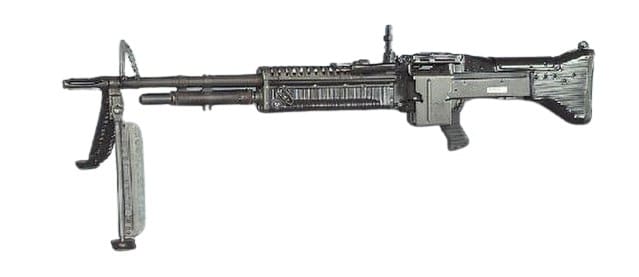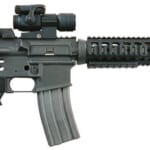
Introduction
The M60 machine gun holds a legendary status in military history. Nicknamed "The Pig" by American soldiers due to its weight and appetite for ammunition, this weapon became synonymous with U.S. firepower for much of the late 20th century. Its use across multiple conflicts—from the jungles of Vietnam to the deserts of Iraq—cements its reputation as one of the most significant machine guns ever developed. This article explores the origin, development, manufacturing, battlefield deployment, technical specifications, and lasting legacy of the M60.
Origins and Development: A Weapon Born from World War II
To understand the gun's creation, one must look to World War II, where the U.S. military took note of the effectiveness of German machine gun designs. Two German firearms directly influenced the M60:
- The MG42: Famous for its high rate of fire (1,200–1,500 rounds per minute) and general-purpose role, the MG42 became one of the most feared machine guns of the war.
- The FG42: A revolutionary paratrooper rifle, the FG42 was admired for its lightweight design, gas-operated system, and inline stock, making it a strong candidate for inspiration in creating a modern American machine gun.
The M60’s operating system, however, owes more to the FG42 than the MG42. The FG42 used a tilting bolt system, which was directly copied in the M60 rather than the MG42’s roller-delayed blowback mechanism. Another often-overlooked influence was the Lewis Gun, an early air-cooled light machine gun that helped shape some aspects of the M60's barrel and gas system.

From Prototype to Production: The Making of the M60
The design process began shortly after World War II, with the U.S. Ordnance Corps leading development at Watertown Arsenal and additional input from Bridge Tool & Die Works and Springfield Armory. The final prototype emerged in 1952, designated the T161.
After extensive field trials, refinements were made, and in 1957, the U.S. Army officially adopted the M60 as its standard-issue general-purpose machine gun (GPMG).
Manufacturing and Production
Once adopted, the M60 was mass-produced by multiple manufacturers, including:
- Saco Defense (later absorbed into General Dynamics)
- Maremont Corporation
- U.S. Ordnance (which continues to produce modernized variants today)
Production ramped up significantly during the Vietnam War, with tens of thousands of units produced annually. By the 1980s, total production numbers had exceeded over 250,000 units, making it one of the most widely produced belt-fed machine guns of the Cold War era.
Combat Deployment: The M60 on the Battlefield
Vietnam War (1955–1975)
The M60 saw its first large-scale combat deployment in Vietnam, where it was issued to infantry squads, vehicle crews, helicopters, and riverine units. Its 7.62×51mm NATO cartridge provided long-range stopping power, making it an effective weapon against enemy combatants in jungle warfare.
Soldiers appreciated the gun's firepower, but it quickly gained a reputation for mechanical issues in humid conditions, particularly with its quick-change barrel system and feed tray mechanism.
Post-Vietnam Conflicts
Even after Vietnam, the M60 continued to serve in Cold War skirmishes, the Persian Gulf War, and early engagements in Afghanistan and Iraq. By the 1990s, however, its maintenance challenges and reliability concerns led the U.S. military to phase it out in favor of the M240 machine gun, a Belgian-designed firearm that proved more durable in sustained combat.
Technical Specifications and Performance
| Specification | Details |
|---|---|
| Caliber | 7.62×51mm NATO |
| Action | Gas-operated, open-bolt |
| Weight | 23.15 lbs (without ammo) |
| Length | 43.5 inches |
| Barrel Length | 22 inches |
| Rate of Fire | 500-650 rounds per minute |
| Effective Range | 1,100 yards (1,000 meters) |
| Ammunition Feed | M13 linked belt |
| Muzzle Velocity | 2,800 ft/s (850 m/s) |
The M60’s effective range and sustained firepower made it a dominant force on the battlefield. However, common issues included barrel overheating, feed mechanism malfunctions, and frequent part failures, requiring constant maintenance and spare parts.
Successors: The M240 and Beyond
While the M60 was widely used, its reliability issues and complex maintenance requirements led to its gradual replacement in the 1990s with the M240. The M240, derived from the FN MAG 58, proved far more durable under battlefield conditions.
Despite its official retirement from frontline U.S. military service, the M60 remains in use among allied nations, law enforcement units, and specialized forces. Additionally, modernized versions such as the M60E4/Mk 43 and M60E6 have addressed many of the original design flaws, offering improved ergonomics, durability, and reliability.
Comparison to Soviet and Modern Machine Guns
The M60 frequently found itself compared to the Soviet PKM, which also fired a full-power rifle cartridge (7.62×54mmR). The PKM, however, was generally considered more reliable, easier to maintain, and lighter—giving it an edge in many combat scenarios.
Modern machine guns like the FN MAG/M240, HK MG5, and Russian Pecheneg continue to refine the general-purpose machine gun concept, emphasizing durability, modularity, and sustained fire capabilities.
Legacy: The Enduring Impact of the M60
Despite its flaws and eventual replacement, the M60 remains an icon of American military firepower. It was featured prominently in war films, television, and military documentaries, reinforcing its place in the cultural and historical fabric of 20th-century warfare.
Its pioneering role in squad-level fire support paved the way for modern machine guns, and its impact continues to be felt in contemporary military doctrine. Even as newer designs emerge, the M60’s legend as a hard-hitting, battlefield-proven weapon remains undisputed.
Conclusion
The M60 machine gun’s journey from concept to combat legend is a testament to American ingenuity and adaptability. It played a critical role in major military conflicts, demonstrated formidable firepower, and influenced the evolution of modern general-purpose machine guns. While no longer in frontline service, it remains a respected and historically significant firearm that shaped the future of military weaponry.
From the rice paddies of Vietnam to the sands of Iraq, the M60 machine gun has earned its place in history as one of the most recognizable and impactful weapons of the 20th century.
Read more about this iconic weapon here:
If you know of any forums or sites that should be referenced on this listing, please let us know here.






